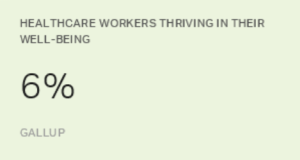2 Remedies for Reducing Burnout Among Healthcare Workers
I spend a lot of time in hospitals as a healthcare consultant. Recently, though, I experienced hospitals in a new light when my aunt faced terminal health problems.
Throughout my aunt’s hospital stay, I was deeply moved by the support and kindness that her caregivers demonstrated. The doctors, nurses, technicians and other medical staff were strangers to my family, yet they displayed endless compassion and determination to provide the best care possible.
This experience gave me a fresh perspective on the importance of an issue I’ve helped many healthcare organizations address: burnout among employees. If healthcare workers feel exhausted, detached and overworked, how can they deliver exceptional, holistic care to people like my aunt?
Unfortunately, burnout among U.S. healthcare employees is a growing problem with far-reaching consequences.
Burnout can undermine not only employee well-being, but also patient outcomes, safety and quality of care. Employees who feel burnout are three times more likely to leave and 63% more likely to take a sick day. For organizations, burnout translates to increased turnover, lost productivity and increased malpractice lawsuits.
As healthcare leaders continue to tackle unrelenting change and uncertainty, burnout is a problem they cannot afford. The following foundational strategies are instrumental for healthcare leaders seeking to stem burnout and, in turn, promote employee, business and patient outcomes.
Provide Holistic Employee Care
Like medical professionals who offer holistic patient care, healthcare leaders need well-being strategies that focus on more than employees’ physical health. By investing in employees as people, not just workers, healthcare leaders deliver exceptional care for the caregivers.
Gallup, in partnership with Sharecare, has developed a well-being model that considers the ways employees relate to their jobs and, in turn, perform at work. We define well-being as five interrelated elements: purpose, social, financial, community and physical. Our analytics show that when employees are thriving in at least four of these elements, they are four times less likely to feel burnout at work.
With just 6% of healthcare workers thriving in all five elements of well-being, there is serious room for improvement in healthcare employees’ well-being.
By adopting a comprehensive approach to employee well-being, healthcare leaders can give workers the energy, focus and adaptability they need to perform at their best each day. In fact, Gallup analytics show that healthcare workers with high well-being are more likely to be resilient and recover quickly from stress, illness or hardship. They’re also two times less likely to look for a new job than employees with lower well-being.
To enrich employee well-being, healthcare leaders must do more than just offer a well-being program; they need to create an organizational culture that allows employees to actively participate in it. That is, leaders need to infuse well-being in their organizational beliefs, behaviors and systems.
Aim Employee Engagement Efforts at Burnout
At Gallup, we have learned through decades of analytics that there are 12 basic elements of employee engagement — that is, 12 drivers of workers’ involvement in, enthusiasm about and dedication to their work. For example, employees need to feel that someone at work encourages their development — especially millennials, 87% of whom rate “professional or career development opportunities” as important to them in a job.
Healthcare organizations with high employee engagement not only boost patient outcomes, but also diminish employee burnout: Gallup analytics show that engaged employees are four times less likely to feel burnout at work.
To deepen employee engagement, leaders and managers need to use proven analytics to discover where employees’ needs are unmet, then proactively meet those needs. This means using employee engagement data to spark meaningful discussions about burnout, establish goals and action items, and promote employee ownership and accountability.
For example, one critical engagement need is providing employees with opportunities to do what they do best every day. It’s up to managers to not only find out what employees do best, but also position employees to apply and develop those abilities. When this engagement need is met, employees are 57% less likely to feel burnout at work. Similarly, when managers provide clear expectations, their team members are 41% less likely to feel burnout.
Because managers account for 70% of the variance in employee engagement, healthcare leaders should ensure that managers are equipped to own their pivotal role in meeting employees’ engagement needs. This means going beyond simple how-to guides — healthcare leaders need to understand what characterizes the world’s most successful managers and how great managers successfully reduce burnout.
When managers are motivated and equipped to fulfill employees’ basic workplace needs, they amplify employee engagement and can better recognize and respond to signs of burnout.
Learn more about how Gallup helps healthcare leaders set up their employees for success:
- Learn how Gallup can help you get better results by focusing on the employee experience.
- Inquire about our comprehensive well-being solutions that produce results for people and businesses.
- Download our employee engagement meta-analysis that details the link between engagement and performance.
- Listen to our “Self-Assessment for Healthcare Leaders: Are You a Trusted Leader?” webinar that dives into the qualities healthcare workers want most from their leaders.
